The Featured Creatures collection provides in-depth profiles of insects, nematodes, arachnids and other organisms relevant to Florida. These profiles are intended for the use of interested laypersons with some knowledge of biology as well as academic audiences.
This article describes the identification, biology, and ecology of the oriental beetle, Anomala orientalis (Waterhouse 1875). Anomala orientalis is native to eastern Asia and one of several exotic scarab beetle species in the United States commonly known as white grubs. This insect and many of its close relatives are considered frequent pests of turfgrasses and some ornamental plant species throughout the northeastern United States.
Synonymy
Anomala orientalis was originally described as Phyllopertha orientalis in 1875 (Jameson et al. 2003, CABI). The name Blitotherpa orientalis was also historically used in Japanese literature (Alm 1996). This species has also been classified within the genus Exomala by Baraud in 1991 (Jameson et al. 2003). As the genus, Exomala, is poorly characterized and delineated, Anomala is the currently recognized genus, which includes more than 1,000 other recognized species (Jameson et al. 2003).
Distribution
Anomala orientalis is likely native to Japan (Jameson et al. 2003) or the Philippines (Alm et al. 1997) and is established in the Korean peninsula (Choo et al. 2002). Anomala orientalis was introduced to Hawai’i before 1908 and was first documented in the continental United States in Connecticut in 1920 (Alm et al. 1997). It has since spread throughout many eastern US states (Figure 1). Currently, 20 US states have documented Anomala orientalis populations: Connecticut, Delaware, Georgia, Hawai’i, Maine, Maryland, Massachusetts, Michigan, New Hampshire, New Jersey, New York, North Carolina, Ohio, Pennsylvania, Rhode Island, South Carolina, Tennessee, Virginia, West Virginia, and Wisconsin (CABI). There are many other scarab beetle species (e.g., Euphoria spp. flower beetle) with similar appearance and developmental life histories that may be easily confused with Anomala orientalis in the field.

Credit: CABI Summary Data, accessed 3 July 2023
Life Cycle
As with other beetle species, Anomala orientalis undergoes complete metamorphosis, progressing through egg, larva, pupa, and adult life stages. One adult female Anomala orientalis will deposit an average of 20–30 eggs during her lifetime (Wenninger 2006). The eggs are laid one at a time, with the most deposited on the day immediately after mating than any other day (Wenninger 2006). Moist soil is preferred for oviposition sites, and newly laid eggs can survive up to seven days completely submerged in water if the area floods (Alm 1996). Eggs typically hatch after 14 days (Alm 1996) into larvae, which feed on fine rootlets of turfgrasses and dead organic matter, remaining in the top 2 inches of soil (Alm 1996). When soil temperatures reach 59oF, larvae begin to burrow downwards for insulation to increase chances of survival during the winter. Larvae will become inactive once soil temperatures reach 50oF (Alm 1996).
There are one- and two-year variants of Anomala orientalis (Reding 2007). Both variations can be found in the same geographic location, although the proportions differ across populations (Reding 2007). The reason for these distinct variants is unknown (Reding 2007). However, the variant that takes one year to complete its development spends the winter as a 3rd instar larva. The variant that takes two years to develop spends its first winter as a 2nd instar larva and its second winter as a 3rd instar (Reding 2007). Larvae overwinter 8–17 inches beneath the soil surface and migrate upwards in the spring for 4–5 more weeks of active root feeding (Alm 1996). After their spring feeding, larvae migrate back down into the soil to pupate (Alm 1996). Adults emerge in late spring to early summer (Reding 2007) and live for about two weeks, during which their primary goal is to successfully mate and reproduce (Facundo et al. 1999).
Description
Eggs
The eggs are oviposited 2–4 inches deep beneath the soil surface (Alm 1996). Freshly deposited eggs are milky white, ovoid, and smooth, averaging 1.2 mm by 1.5 mm (.05 inch) (CABI). After a few days in moist soil the eggs become larger and more spherical, averaging 1.6 mm by 1.9 mm (CABI).
Larvae
The larvae are C-shaped white grubs (Figure 2) that undergo three instar stages (Alm 1996). Larvae appear almost identical to those of the Japanese beetle, Popillia japonica, but they differ in the arrangements of bristly hairs or spines on the underside of the tip of the abdomen, called the raster (Alm 1996). Anomala orientalis has parallel lines of spines, while Popillia japonica has a V-shaped spine arrangement (Figure 3) (Alm 1996). The larvae have a transverse anal slit and two parallel rows of 10–16 setae along their median line (CABI). First instar larvae range from 4–8 mm (1/4 inch) long with a head width of 1.2 mm (CABI). The second instar larva averages 15 mm (3/5 inch) long with a 1.9 mm head width (CABI). Third instar larvae are 20–25 mm (1 inch) long with a head width of 2.9 mm (CABI).
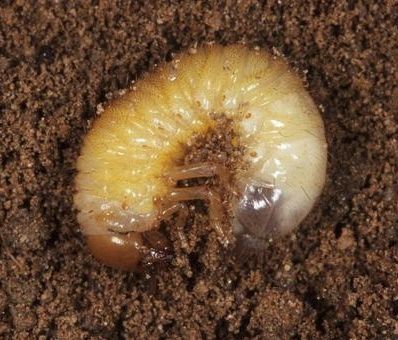
Credit: Jim Baker, North Carolina State University (NCSU) licensed under a Creative Commons Attribution-Noncommercial 3.0 License

Credit: Turfgrass Insects of the United States and Canada, used with permission from Cornell University Press
Pupae
The pupae are approximately 10 mm (3/8 inch) long and 5 mm wide at their broadest point (CABI). They are exarate, meaning their appendages are clearly visible and not obscured by the pupal case.
Adults
Adult Anomala orientalis are roughly 13.5 mm (1/2 inch) by 7.5 mm (CABI). They have lamellate antennae, with the segments at the tip flattened and pressed together in a fan-like shape (Figure 4). Their color ranges from light tan to black (Figure 5), with highly variable patterning and markings (Figure 6).

Credit: Whitney Cranshaw, Colorado State University (CSU) licensed under a Creative Commons Attribution-Noncommercial 3.0 License
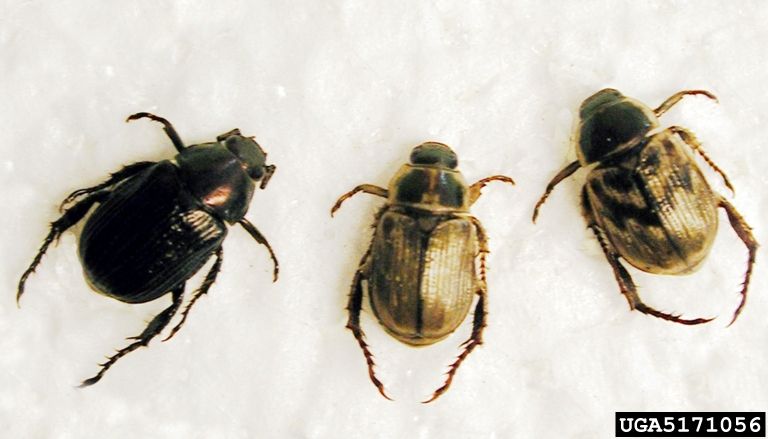
Credit: Michael Reding, USDA Agricultural Research Service (UGA) licensed under a Creative Commons Attribution-Noncommercial 3.0 License
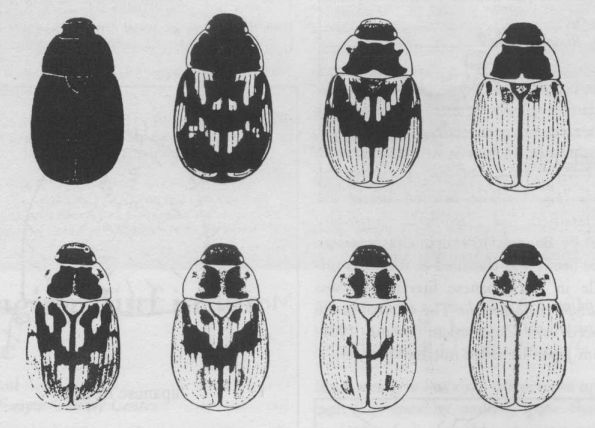
Credit: Friend 1929 via Alm 1996
Hosts
Adult Anomala orientalis are herbivorous, feeding on flowers of many different species. Adults are generally not considered economic pests (Alm 1996). This insect is a generalist known to feed on roses, hollyhock, phlox, petunias, and dahlias (Alm 1996). The root-feeding white grub larvae are most commonly associated with turfgrasses, including Kentucky bluegrass, perennial ryegrass, and sheep fescue (Alm 1996). They have also been found in a variety of nursery plants, such as Canadian hemlock (Alm 1996).
Economic Importance
Anomala orientalis is one species of a complex of white grubs that includes other species known to feed on and damage the root systems of various cool season turfgrasses. This complex includes similar invasive scarab beetles – the Asiatic garden beetle, the Japanese beetle, and the European chafer (Reding 2007). These insects are highly destructive pests of turfgrasses, especially in golf courses and other highly maintained turfgrass areas. At high densities, larval feeding can cause wilting, discoloration, and death (Figure 7) as the larvae consume the turfgrass roots and prevent the plant from taking up water and nutrients (Richmond 2016). In addition to direct damage, vertebrates (e.g., raccoons, opossums) frequently tear up turfgrasses as they forage for grubs (Richmond 2016). The combination of aesthetic damage and physical destruction of infested turfgrass areas can be very expensive to correct and manage. Thus, Anomala orientalis and other white grubs are frequent targets of preventive insecticide applications in highly maintained turfgrass systems. They are also known to attack the roots of woody ornamental plants in nurseries, which increases their vulnerability to pathogens and weeds (Reding 2007).
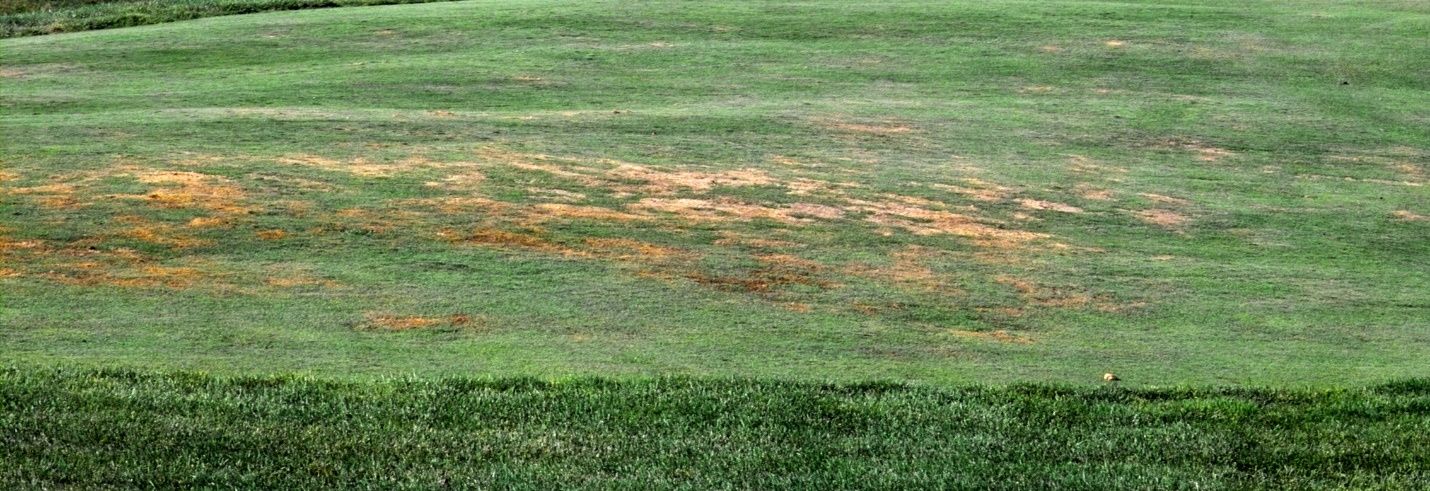
Credit: Richmond, Purdue Extension
Management
There are multiple biological control management approaches for Anomala orientalis. In some cases, the parasitoid wasp Tiphia vernalis can effectively suppress the white grub complex in nearby turfgrass areas (Reding 2007). However, its usefulness as a biological control agent can be limited if there are not sufficient attractive resources like flowering plants nearby or if they are exposed to frequent broad spectrum insecticide applications. Adult T. vernalis exposure to organophosphate or neonicotinoid insecticides has been shown to reduce white grub parasitism rates and offspring survival (Oliver et al. 2005).
Entomopathogenic (insect parasitic) nematodes, including Steinernema spp. and Heterorhabditis bacteriophora, have been effectively utilized against Anomala orientalis on golf courses, as has the fungal pathogen Beauveria brongniartii (Choo et al. 2002). Infective juvenile nematodes can be purchased commercially and applied to the soil surface, following label instructions (Choo et al. 2002). The pesticide Bacillus thuringiensis servovar japonensis strain Buibui is a naturally derived bacterium that can be an effective chemical control (Alm et al. 1997).
Synthetic sex pheromone traps (Figure 8) are available to monitor for active adult Anomala orientalis populations (Facundo et al. 1999). Pheromone traps are not an effective control tool, but adult presence can help predict whether the subterranean larvae will be present before damage occurs (Facundo et al. 1999).
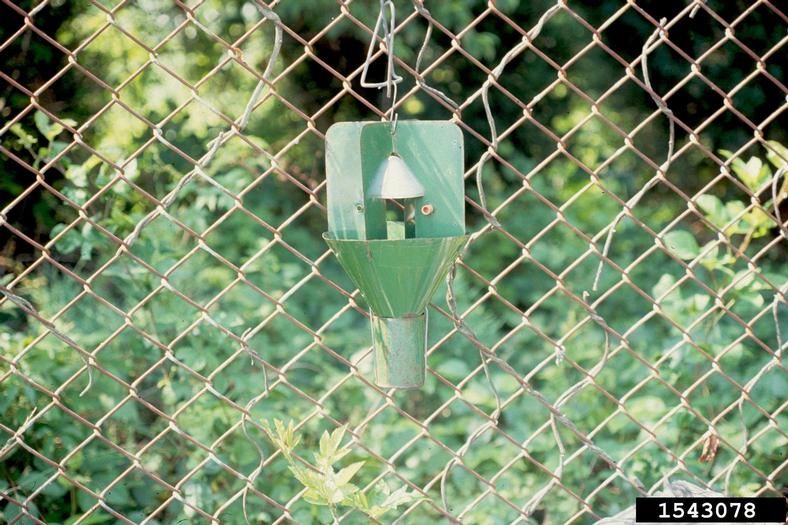
Credit: Jim Baker, North Carolina State University (NCSU) licensed under a Creative Commons Attribution-Noncommercial 3.0 License
Although labor-intensive, if damage is suspected, cutting into the soil around the damage and lifting up on the grass foliage to see if it has an intact root system is an effective way to survey for white grubs in the soil. Using a flat-bladed spade, a sample of turfgrass is cut on three sides to a depth of 7–10 cm, then peeled back like a flap (Figure 9). The overturned soil is then broken up and searched for grubs. The action threshold, or the density of white grubs at which insecticide application may be warranted, for this species is eight grubs per square foot of turf (Alm 1996). As with all white grub pest species, preventive applications of systemic insecticides are a primary approach for management and are timed to target first instar larvae (Reding 2007). Examples of such products include neonicotinoids (e.g., imidacloprid, clothianidin, thiamethoxam) and diamides (e.g., chlorantraniliprole, tetraniliprole).
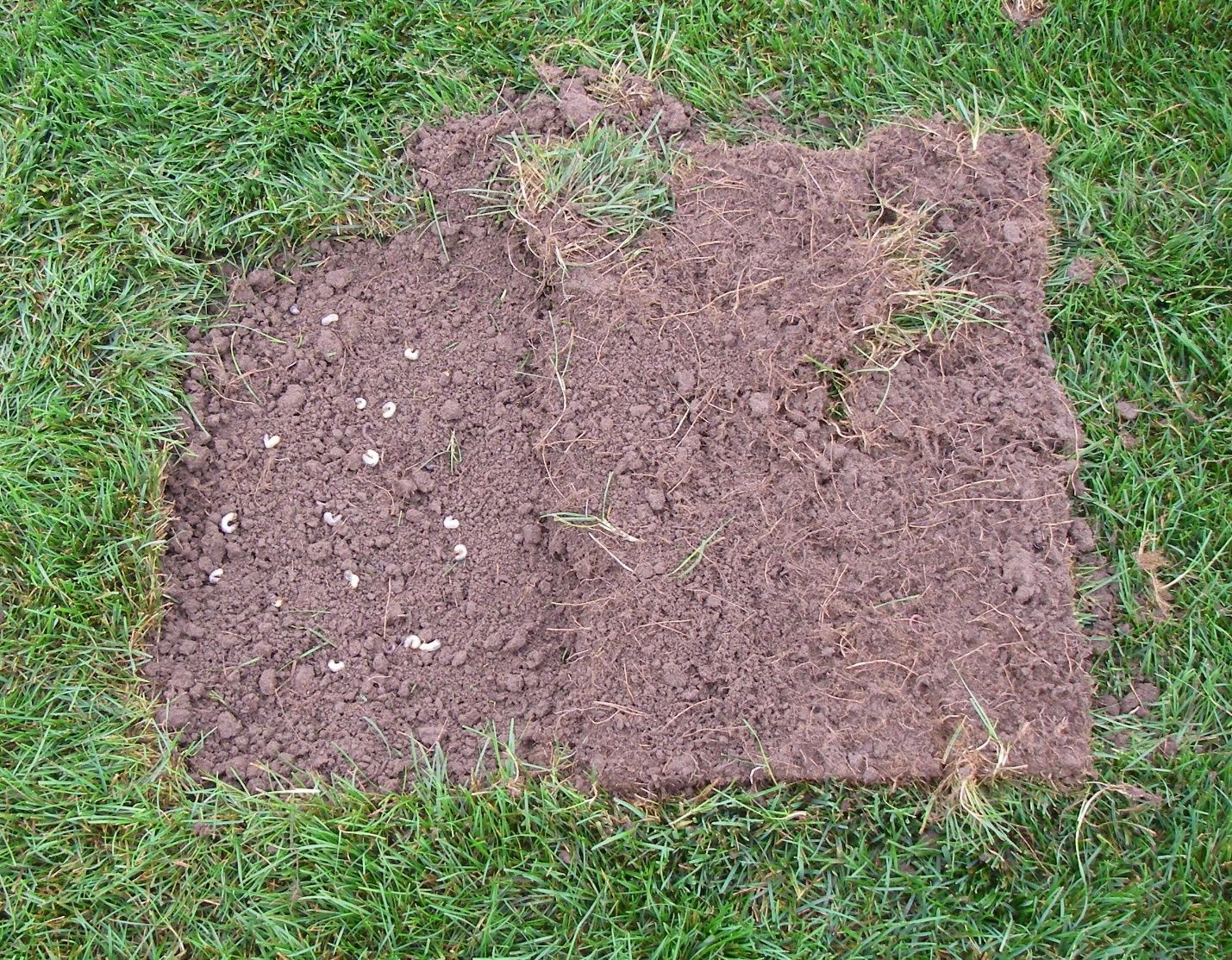
Credit: Richmond, Purdue Extension
Selected References
Jameson ML, Paucar-Cabrera A, Solís A. 2003. Synopsis of the new World genera of Anomalini (Coleoptera: Scarabaeidae: RUTELINAE) and description of a new genus from Costa Rica and Nicaragua. Annals of the Entomological Society of America. 96: 415–432.https://doi.org/10.1603/0013-8746(2003)096[0415:SOTNWG]2.0.CO;2
Alm Steven R. 1996. The Oriental Beetle. TurfGrass Trends. 5(7): 9–13. http://archive.lib.msu.edu/tic/tgtre/article/1996jul9.pdf
Reding M, Klein M. 2007. Life history of Oriental Beetle and other scarabs, and occurrence of Tiphia Vernalis in Ohio Nurseries. Journal of Entomological Science. 42(3): 329–340. https://doi.org/10.18474/0749-8004-42.3.329
Centre for Agriculture and Bioscience International: Invasive Species Compendium. 2019. Exomala orientalis (oriental beetle). https://www.cabi.org/isc/datasheet/5510
Alm RS, Villani GM, Yeh T, Shutter R. 1997. Bacillus thuringiensis serovar japonensis Strain Buibui for control of Japanese and Oriental beetle Larvae (COLEOPTERA: SCARABAEIDAE). Applied Entomology and Zoology. 32(3): 477–484. https://doi.org/10.1303/aez.32.477
Choo HY, Kaya HK, Huh J et al. 2002. Entomopathogenic nematodes (Steinernema spp. and Heterorhabditis bacteriophora) and a fungus Beauveria brongniartii for biological control of the white grubs, Ectinohoplia rufipes and Exomala orientalis, in Korean golf courses. BioControl. 47: 177–192 https://doi.org/10.1023/A:1014559729607
Facundo HT, Linn CE, Villani MG et al. 1999. Emergence, Mating, and Postmating Behaviors of the Oriental Beetle (Coleoptera: Scarabaeidae). Journal of Insect Behavior. 2: 175–192. https://doi.org/10.1023/A:1020910732029
Oliver JB, Mannion CM, Klein MG et al. 2005. Effect of insecticides on Tiphia vernalis (Hymenoptera: Tiphiidae) oviposition and survival of progeny to cocoon stage when parasitizing Popillia japonica (Coleoptera: Scarabaeidae) larvae. Journal of Economic Entomology. 98(3): 694–703. https://doi.org/10.1603/0022-0493-98.3.694
Richmond DS. 2016. Managing white grubs in turfgrass. Purdue University Cooperative Extension Service. https://extension.entm.purdue.edu/publications/E-271/E-271.html
University of Georgia - Warnell School of Forestry and Natural Resources. 2018. Oriental Beetle Anomala orientalis (Waterhouse, 1875). Forestry Images. Retrieved 2021 from https://www.forestryimages.org/browse/subthumb.cfm?sub=7736
Wenninger EJ, Averill AL. 2006. Effects of delayed mating on reproductive output of female oriental beetle Anomala orientalis (Coleoptera: Scarabaeidae). Agricultural and Forest Entomology. 8(3): 221–231. https://doi.org/10.1111/j.1461-9563.2006.00300.x